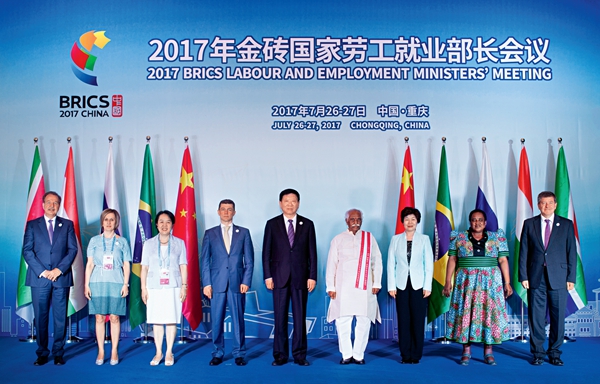By CAI CHUNLIN
AS BRICS celebrates the start of its second decade this year, the priority for future cooperation should be clearly stressed at this crucial time. It is more important to consolidate internal cooperation than to simply expand the number of member states. In my opinion, while carrying forward the spirit of openness, inclusiveness, and win-win cooperation, the mechanism should expand its circle of friends through the model of “BRICS Plus” so as to make a greater contribution to the creation of a community of shared future for mankind.
Internal Relations Sets a Solid Foundation
Maintaining mutual strategic trust and sticking to cooperation between member states is the bedrock of the BRICS mechanism. Cooperation over the past decade has built mutual political trust and a tacit understanding between group members that is hard to establish but easy to destroy. Faced with an unclear vision of the world and doubts about the BRICS mechanism from the international community, a discrepancy in strategic ideas could shake the foundations of the BRICS cooperation and even ruin the hard-won achievements of the past decade. It is not rare for the BRICS countries to have different opinions on certain issues. But the key lies in the members’ joint determination to help the mechanism function more effectively through negotiations, communication, and discussion.

An advancement of internal relationships is the best way to refute those doubts. The development of the BRICS mechanism relies heavily on sound cooperation ties between its members. Opposition has never ceased since the day the concept of BRICS was posited. Goldman Sachs, for one, shut down its BRIC fund in October 2015 and merged it with a broader emerging-markets fund portfolio. The move has been interpreted by some media outlets and academics as a sign that BRICS is losing its attraction and that the BRICS era is over. In the face of this, BRICS countries should cherish the mechanism and strive to maintain the mechanism’s vitality and global influence by enhancing the efficiency and effectiveness of their cooperation.
Moreover, synergizing and interacting with the development strategies of each member is a key part in promoting internal relations. At present, Russia, Brazil, and South Africa are aligning their economic strategies relatively well and are actively taking part in the Belt and Road Initiative. China-India synergy is vital for the group’s internal relations. India has developed two projects as part of its plan on peripheral relations. The Spice Route Project aims to revive an ancient trading route travelled by merchants and explorers in search of spices, which made its way through 31 countries in Asia and Europe that used to have close trading ties with India. Project Mausam is named after Indian sailors who used seasonal monsoons winds to quicken their journey. The voyages, which usually encompassed regions around the Indian Ocean, the Arabian Peninsula, and East Africa, allowed for cultural exchanges and trade.
To some extent, the China-proposed Belt and Road Initiative can be aligned with the above mentioned Indian projects. It is a priority for both sides to hold dialogues under the BRICS framework to link their regional development initiatives. Moreover, mutual understanding should be given to the projects and a consensus should be reached so that the projects can be mutually complementary and reinforce each other.
Not a Numbers Game
Recently, some critics have suggested it is imperative that BRICS accept new members from 11 emerging markets who are also members of the G20. Meanwhile, other critics have advised including Turkey, Indonesia, Mexico, Egypt, and South Korea in this mechanism to expand it into “BRICS TIMES.” In their eyes, differences among the BRICS countries are increasing. As China makes up nearly 70 percent of the GDP growth of the group countries, having new members may be a way to settle internal disagreements while expanding consensus.

Topics including improving the social security system and increasing vocational training are highlighted at the 2017 BRICS Labour and Employment Minister' Meeting held in Chongqing, from July 26 to 27.
On the other hand, some emerging economies have the desire to join the BRICS mechanism in a bid to boost their own development, which reflects the platform’s rising attraction. Nevertheless, a mere increase in the number of member states might cause slower implementations of projects, wider divergences of views, and more issues left unresolved.
Various kinds of cooperation can be carried out between emerging economies and BRICS. In my opinion, emerging economies should board the express train of achievement that BRICS has made and share its benefits with the group members to realize a coordinated development. Jim O’Neill, the economist who coined the acronym “BRICS,” doesn’t favor an expansion of the BRICS grouping. A platform for cooperation, BRICS is expected to extend its collaboration with more emerging economies in wider sectors, but in the immediate future, it is not advisable for BRICS to enlarge its numbers.
Substantially Upgrading Internal Relations
Speaking of promoting substantial collaboration, cooperative models are urgently needed to focus on joint progress. Efforts can be made in five areas:
First, a secretariat to beef up BRICS cooperation and development, and a fund to support international industrial collaboration, should be set up, with the focus on increasing industrial cooperation with emerging economies and generating more substantial benefits in these markets.
Second, prompt responses should be given to major issues and risks while a coping mechanism in this regard should be established, so as to pool strengths and avoid losing group cohesion.
Third, providing a mechanism to facilitate benefit compensation and equilibration would be helpful in resolving internal contradictions within BRICS partnerships. Based on this, compensation should be given to parties suffering the loss of short-term benefits while communication and coordination be strengthened during collaborations.
Fourth, multinationals are encouraged to play a more active role by virtue of better synergizing themselves with the BRICS mechanism and perfecting their global service system.
Last, existing regional cooperation mechanisms need integration. For instance, an integrated clearance system should be adopted among the five countries to facilitate trade, investment, and tourism.
As an integral whole, BRICS should conduct its coop-eration like a concentric circle. The model of “BRICS plus other countries” is proposed to expand the circle of friends. In other words, the five members – the core of the group – should expand their cooperation with other economies as an entity. Other emerging economies may take part in the cooperation under the framework “Five Plus N,” which would guarantee the independency, autonomy, flexibility, and effectiveness of the BRICS mechanism while injecting positive energy into global governance.
Advocating a modern philosophy featuring reciprocity and win-win cooperation, the BRICS mechanism has outshined obsolete concepts and models in international relations. Openness, inclusiveness, and win-win cooperation – the foundation of the group’s cooperation – have been continually intensified over the past decade. Today, it is necessary to instill this spirit in people in each of the BRICS countries to further unleash the vitality of internal cooperation. More moves embodying the BRICS spirit are expected to contribute wisdom and solution to the building of a community of shared future for mankind.